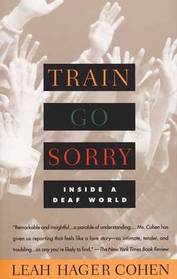Helpful Score: 5
This is a really, really good look into the world of deaf culture - a world most of us are completely ignorant of. Well written and extremely informative. Deals with the many controversies and political struggles within the deaf world. Well worth your attention
Helpful Score: 2
The inside look at the Lexington School is only a part of this book. The author weaves its history with her own (she only lived at the school until she was 7, and did not learn to sign there), her father's (he is the superintendent of the school, and the hearing son of deaf parents), an inner-city student named James, and a Russian-born, multi-lingual deaf girl named Sofia. James' family gives him no support; at times there is not even enough food to go around. If he could hear, would he be in jail with his brother, or peddling drugs? Did his deafness save him from the culture of his family, and does he see that as a good thing? Sofia's parents, who do not sign, speak Russian at home. They do not support Sofia learning Hebrew so she can have a bat mitzvah, nor do they want her to go to college and leave them stuck with a younger deaf daughter that Sofia has been raising for them. Which culture does Sofia belong to: Jewish, Russian, American, or Deaf? Is it more important to fulfill her own potential, or her parents' wishes? All in all, a very interesting book.
Helpful Score: 1
This was an excellent book on some major events in Deaf culture and the history of the Lexington School for the Deaf in New York. Ms. Cohen acts as narrator and translator throughout the book and talks about the shift the school goes through from being strictly an oral school, to developing their manual curriculum and all the controversies in between the two. A definate eye-opener for those who are not familiar with Deaf history, culture and lifestyles.
Helpful Score: 1
Written by the daughter of an administrator for the Lexington School for the Deaf in NYC, this book is truly an insider's experience as she and her two siblings are raised within the residential portion of the school. Although Leah and her family have normal hearing, they are integrated into the deaf ASL culture at Lexington. Her essays address topics relating to mainstreaming in public schools, the beauty and versatility of American Sign Language, cultural aspects relating to deafness and language, and funding difficulties for public residential schools. I highly recommend this thought-provoking memoir.




